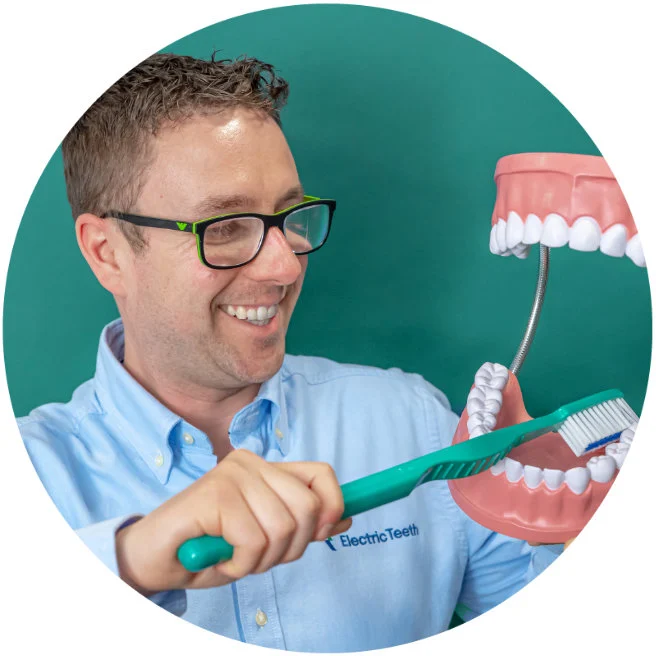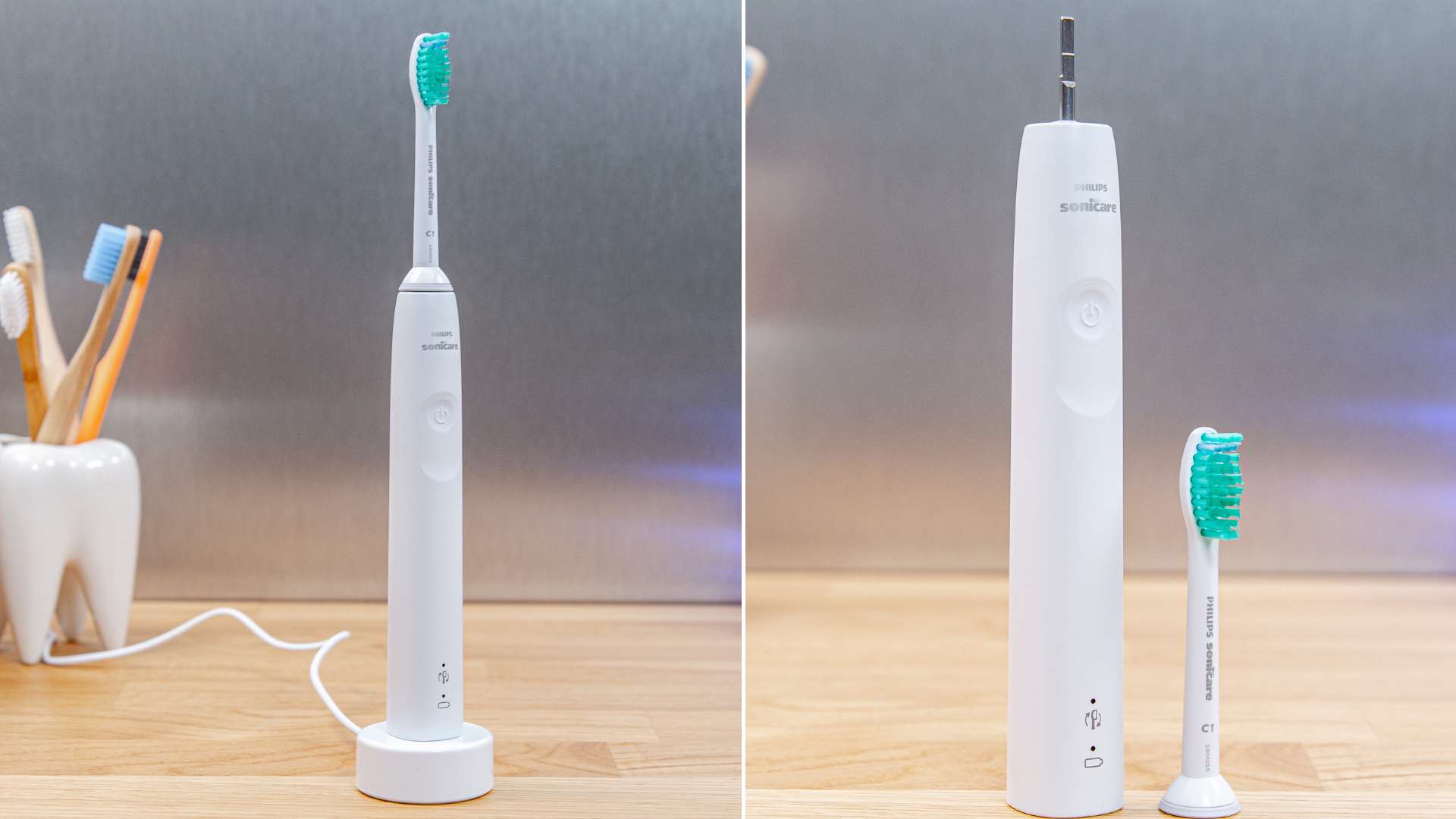
A very likable brush, but less powerful than other Sonicare models
The Sonicare 3100 series is slim and has the essential features I recommend. There is lots to like about this brush — I could happily use it daily.
It’s not as powerful as other Sonicare brushes, though. For similar money, you can get the 4100 Series which has a stronger feeling motor.

Pros |
Cons |
|---|---|

Slim handle design – stylish & easy to keep clean |
Battery life isn’t as good as most other Sonicare brushes |

2 intensity settings – choose between low and high power |
Sonic motor configured differently to premium models |

Reminds you when to replace the brush head |
USB charger makes it less convenient for some |

USB charging stand makes it more convenient for some |
These two brushes are a better overall choice
Whilst the Sonicare 3100 Series gets the job done, there are a couple of other brushes you could consider.
The Oral-B Smart 2000 is similarly priced to the 3100 Series but works out cheaper in the long run because the brush heads aren’t as expensive.
If you want to stick to the Sonicare range, it’s worth considering the 4100 Series. It’s a touch more expensive, for this, you gain a more satisfying clean because the motor has been tuned differently.

The 3100 doesn’t overcomplicate things
Too often products are more complicated than they need to be. Thankfully the 3100 Series isn’t.
You can switch between 2 brushing intensities
It only has 1 cleaning mode, but with the choice of a high or low intensity. Just press the power button to switch between them. Unfortunately, there are no labels or icons on the handle to show which you have selected. You can tell the difference between them based on the sound and intensity.
The high mode is my preference as it delivers the most satisfying clean.
Low is a welcome option and ideal for when your teeth and gums feel a bit tender or inflamed. It’s good for helping first-time electric toothbrush owners get used to their new brush.
The 3100 also has an EasyStart mode, which gradually increases the brushing intensity over the first 14 sessions to ease you in.
There is no whitening or gum care mode. Despite the common misconception that additional modes bring extra benefits, they rarely do.
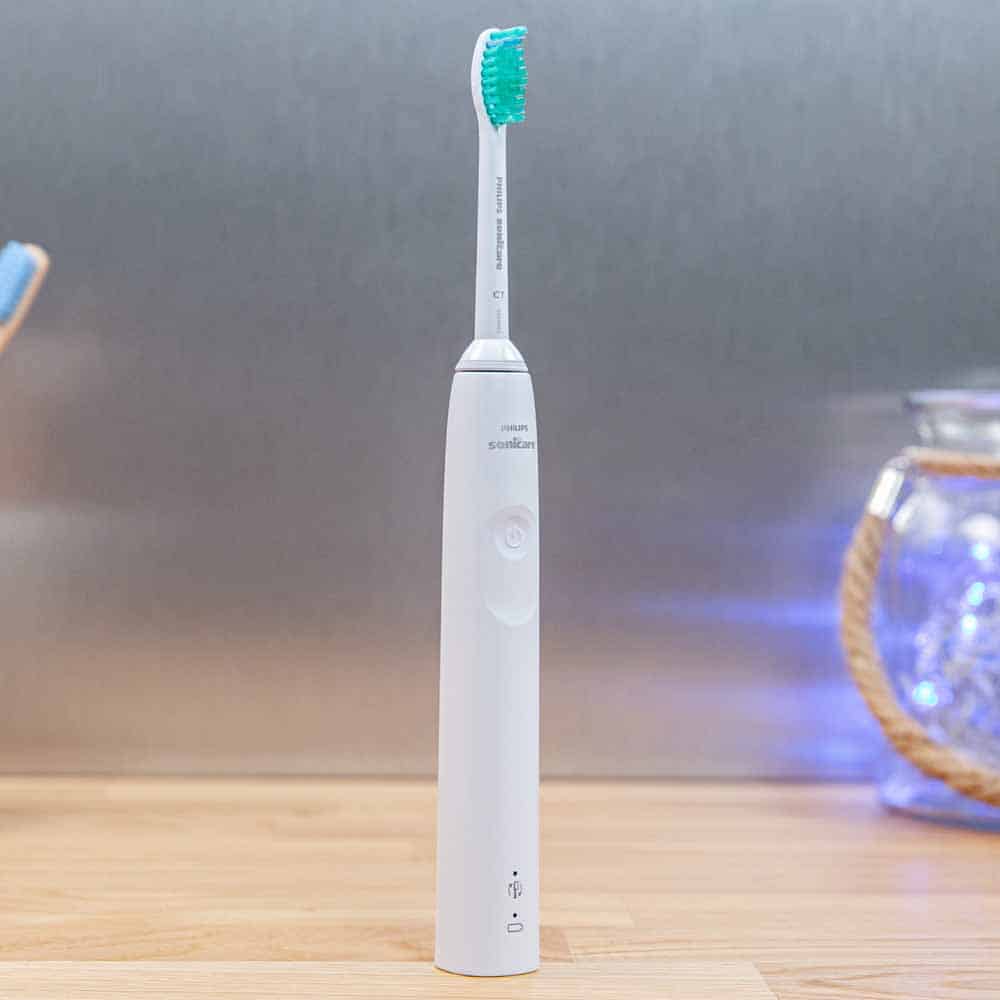
The 2 minute timer and pacer encourage even brushing of your teeth
Keeping things simple is the 2 minute timer that turns the brush off automatically when the dentist recommended 2 minutes of brushing time has passed. If you turn the brush off yourself, you haven’t brushed for long enough.
Brushing for the right duration is one thing, but another is to give all your teeth fairly equal attention. Failing to do so can lead to problems. You need to brush the inner, outer and biting surfaces of the teeth.
To help with this the 3100 has a pacer built in. At 30 second intervals, the timer pauses the bristle motion. It creates a change in the sound and brushing sensation. This is your cue to move between the 4 sections of the mouth until all have been brushed.
Brushing time and technique are more important than any particular toothbrush. It’s therefore worthwhile familiarizing yourself with how a timer and pacer work to get maximum benefit.
The pressure sensor helps to stop you from brushing too hard
Too much pressure can cause wear on the teeth and gums and in the long term result in irreversible damage. The 3100’s built-in pressure sensor can help you if you know you brush too hard.
The handle vibration pattern changes whilst it detects too much force is being applied. At the same time, the brushing sensation and sound alter.
Where you get a sizable visible light on many Oral-B brushes, you don’t on the 3100. Technically the BrushSync replacement reminder LED also flashes amber. Given its position and size, it is not the easiest to see.
Don’t worry if you end up activating the pressure sensor occasionally, I still do. You just want to correct frequent forceful brushing.
It cleans your teeth well despite the less powerful motor
The C1 ProResults brush head does a good job of cleaning all over the tooth surface and along the gumline. It is one of our top picks from the wide and confusing range of Sonicare brush heads.
Larger than the round brush heads on Oral-B brushes, it can be trickier to get into the tightest of spaces in the mouth. If you know you have a small mouth, sonic toothbrushes might not be ideal. Consider an Oral-B brush instead.
I have no complaints about the cleaning results achievable with this brush. They are more than satisfactory.
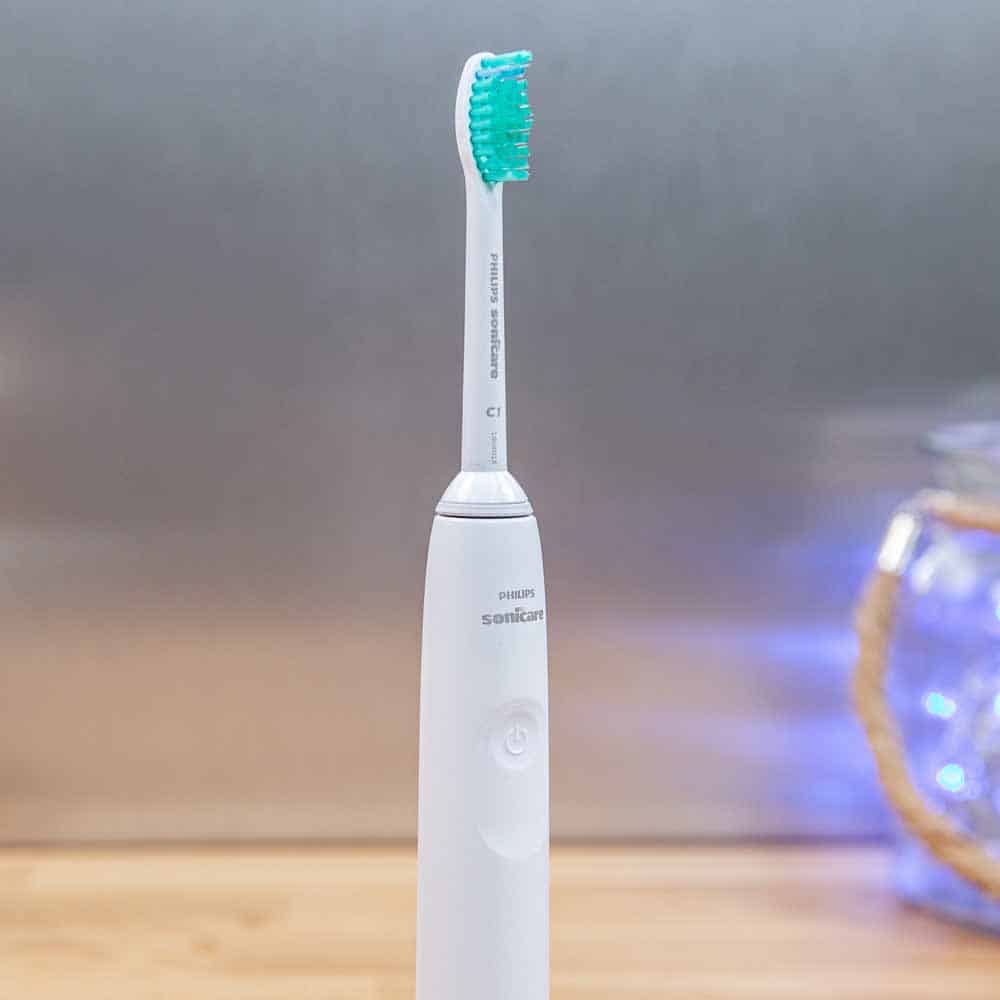
The motor has been tuned differently and doesn't have the 62,000 movements of some of Sonicare's more expensive brushes.
If you haven’t used an electric toothbrush before, the 3100 will still feel intense. But, existing electric brush users may notice the difference. The clean isn’t quite as invigorating.
This difference isn’t a reason to avoid the 3100, but something to be aware of. It still does a perfectly good job of cleaning your teeth.
You do gain a more intense and powerful feeling from the 4100 Series. Its motor is tuned differently. But, it’s still not the same as the most premium Sonicare brushes. Its features and design are identical to the 3100 and shouldn’t cost any more.
A slim, comfortable handle with a minimal design
The 3100’s handle is slimmer and lighter than previous Sonicare models with similar features and price point.
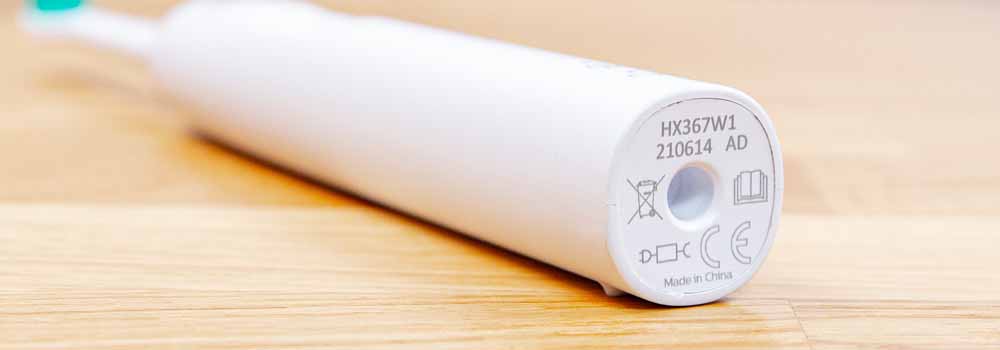
Durable and quality feeling in the hand
The water resistant handle is available in black, pink and white. It doesn’t have lots of textured surfaces and therefore isn’t the most grippy to the touch. Yet, despite this, it doesn’t feel slippery in the hand. A matt finish to the plastic gives a reassuring resistance to the palm and fingertips.
Although rounded, the handle isn’t a perfect cylinder and there is a slightly squared design to the handle which works well.
In the hand, the brush feels solid and well built. There are certainly no creaking or groaning sounds from the plastic. There are no gaps or build issues that I’ve seen.
It stands upright on a countertop and strategically placed nodules on the rear of the handle help prevent it rolling when laid flat.
The minimal design looks good and does make it easier to keep clean.
For those with limited dexterity, the handle might be a bit slimmer than would be ideal.
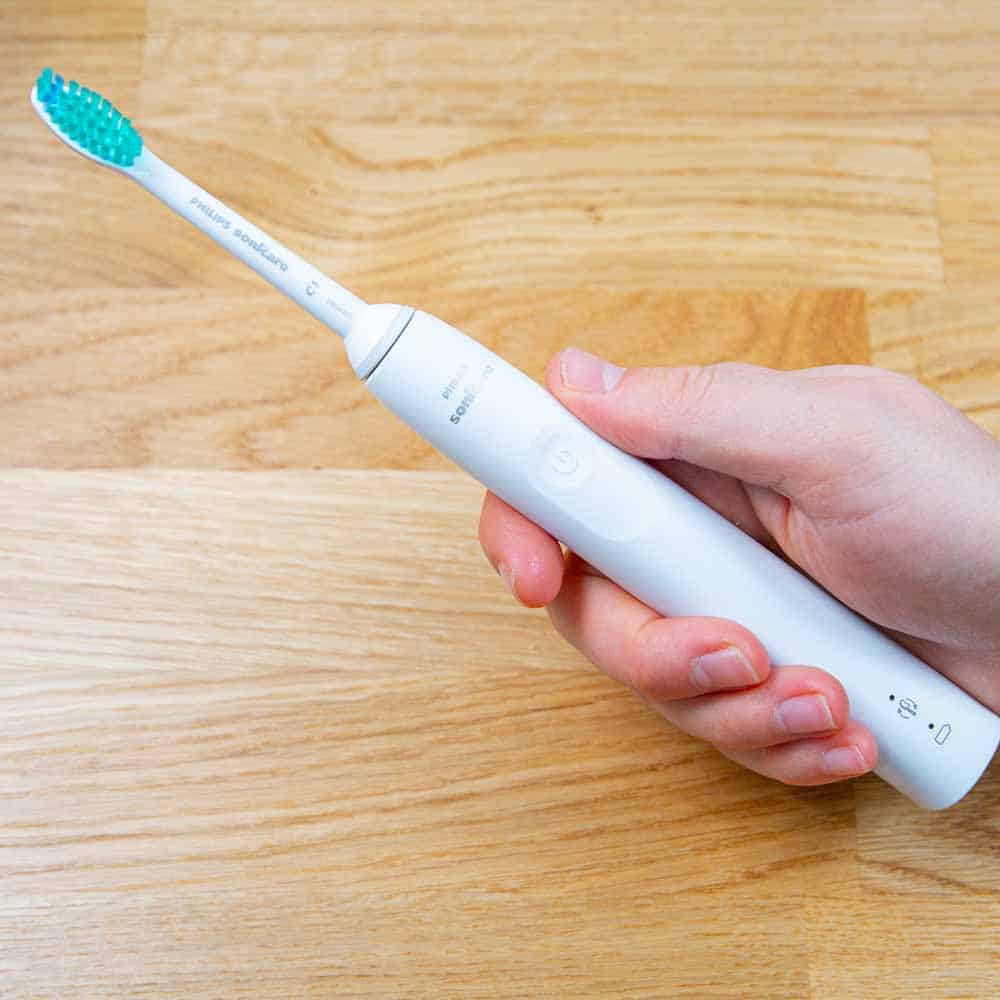
The power button gives nice clicky feedback
The only button on the handle has a concave shape, with a rubber finish and power icon embossed. It’s easily detected by the fingertip and when pressed gives reassuring feedback whilst producing a clicky sound.
It isn’t very firm, great if you suffer from arthritis and painful joints.
You’ll be reminded when you need a new brush head
Do you know the last time you replaced your bristles?
Using them for more than 3 months can result in less effective and more abrasive brushing. This is because the bristles will have worn.
With the 3100 you don’t have to remember or diarise when to replace the head. It can alert you providing you are using a Sonicare head with a Radio Frequency Identification (RFID) chip built into the base.
Each session is logged and when the optimum time to replace the head is reached the handle vibrates and an LED is lit.
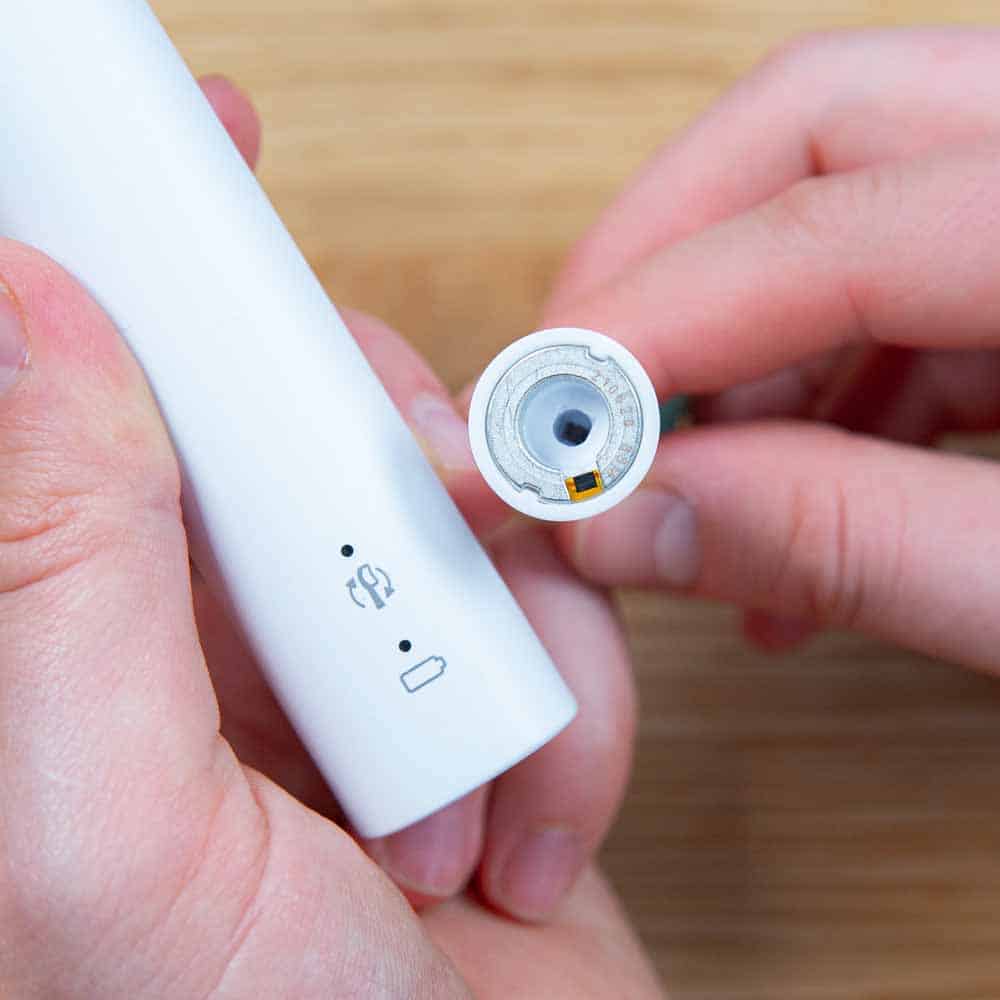
This clever system is otherwise known as BrushSync technology.
The supplied C1 ProResults head should have the chip built in, but might not. Philips has altered the box contents since launch.
Do be aware that the 3100 does not have the mode pairing of some other BrushSync enabled devices.
The 2 week battery life is less than most Sonicare brushes
A rechargeable Lithium-Ion (Li-Ion) battery is sealed inside the 3100 Series brush handle. 2 weeks is the claimed usage time. I achieved an average of 17 days on a full charge.
3-4 weeks of use is now common for an electric brush. Whilst Philips doesn’t advertise such usage times, premium models achieve this.
The 3100’s battery life is a little below average, but this is potentially a trade-off for the slimmer handle. That said there are even slimmer handled brushes like SURI that outperform the 3100, whilst offering a comparable brushing experience.
An in handle LED gives feedback on the battery’s charge level when off and on the charger.
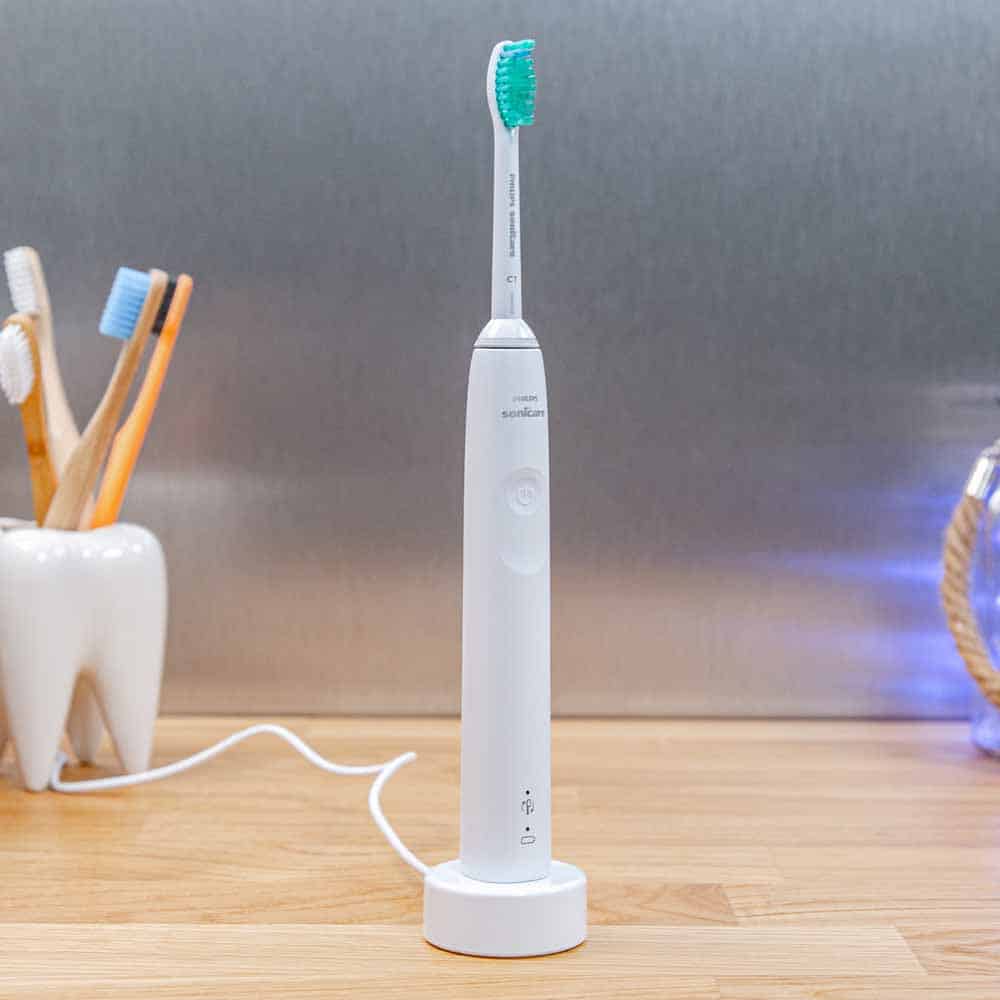
USB charging has some advantages
A new style of charging stand is included. Compared to previous stands with a 2 pin power adapter, this has a USB type A male connector. The cable is hardwired into it and measures 43 inches (110cm) long. The footprint of the stand is smaller too with a more rounded shape.
A protuberance on the top of the stand still exists. This fits into the base of the brush handle.
A full charge can take up to 24 hours.
USB connectivity allows us to take advantage of powering it from more sources such as a computer or portable battery bank. It arguably makes it more travel friendly too
It’s for environmental reasons that no 2 pin USB power adapter is provided. Many of us now have such we can use to connect the 3100 to a power outlet. Although I know some will be frustrated you don’t get one included.

Pricey brush heads add to the overall cost
$64.99 is the very fair retail price for the 3100 Series. This is one of the few brushes I would pay retail for.
Discounts around 20% are possible. Expect to pay around $45-50.
Our top recommended electric toothbrush the Oral-B Smart 2000 is slightly more expensive to buy initially, but works out better value over 3 years of ownership. You can expect to pay $168 compared to the $190 for the 3100 Series.
Sonicare brush heads negatively impact ownership costs. Each costs $13 compared to $8 for an Oral-B head. That’s a premium of about $55 on brush heads alone.
Save $5+ per head by considering generic Sonicare brush heads. They are not made by Philips but are compatible with the 3100 Series The main compromise will be no BrushSync technology to track the head.
The Sonicare 4100 is a better buy in my opinion. It will cost about $10 more giving you the benefit of the more intense cleaning action.
2 year warranty included as standard
An industry average 2 year warranty against defects and workmanship is provided. Unfortunately, no parts on the brush are designed to be user serviceable thus, should it fail, in most cases, they will send you a new brush.
With a need to move to more sustainable approaches the lack of repairability is disappointing.
By no means a defence, Philips has many years of experience behind them. The 3100 appears very well built and I’ve not found any cause for concern during my use.
Environmental impact
We don’t know the exact environmental impact of this particular model, but as a general rule the impact of electric toothbrushes is around 11 times more than a manual brush.
The impact of this model is reduced by excluding a 2 pin power adapter. What good this does is somewhat countered by the fact that the handle and stand come wrapped in plastic and the brush isn’t designed to be repaired.
RFID enabled brush heads further add to the planetary impact.
The brush heads are made of petroleum based plastic rather than more sustainable plant based plastics.
Philips has partnered with schemes such as TerraCycle in some countries, but doesn’t have its own scheme.
Conclusion: a good toothbrush at a fair price
The 3100 Series is a strong choice — it has all the essential features you need.
The slim-handled brush is nice to hold and use. The cleaning results are more than satisfactory and come at an affordable price.
The main downsides are the slightly less powerful motor and 2 week battery life. These are minor factors that can be overlooked.
I’d pick the 4100 Series instead though. Slightly more expensive, its motor is tuned to be more powerful.
Size guide
- Toothbrush height with head - 23.5cm / 9.4 inches
- Toothbrush height without head - 17.5cm / 6.9 inches
- Width - 2.6cm/1 inch
- Depth/thickness - 2.6cm/1 inch
- Weight with head - 98g / 3.4oz
- Weight without head - 93g / 3.3oz
- Package weight - 214g / 7.5oz
Noise
- 57dB
Country of manufacture
- China



